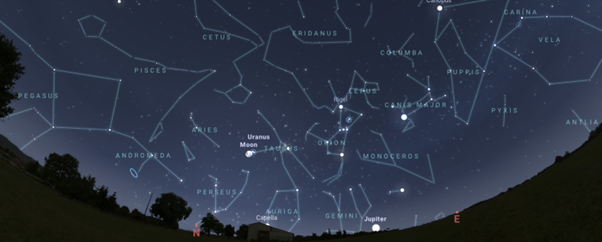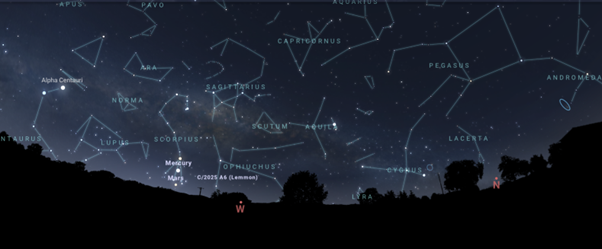What's up in the night sky? November's celestial highlights
Donna Burton
06 November 2025, 6:40 AM
 The Leonids Meteor Shower (The Leonids)
The Leonids Meteor Shower (The Leonids)November offers a remarkable array of astronomical events, and you do not need specialised equipment or advanced knowledge to enjoy them.
Whether you are a seasoned observer or simply curious about the cosmos, this month’s night sky has something for everyone.
The Southern Cross sets as it is getting dark and won’t be visible until early morning in the South for the next couple of months.
Scorpio and Sagittarius are setting in the west with Orion (the Saucepan) about to dominate the sky for summer.
The Leonid Meteor Shower: A Trail of Cometary Dust
The Leonid meteor shower will peak during the night of 17–18 November, with optimal viewing in the early hours before dawn.
This year, the absence of a bright Moon provides excellent conditions for observing meteors.
Under dark skies, observers may see between 10 and 15 meteors per hour.
The Leonid’s originate from Comet 55P/Tempel-Tuttle, which orbits the Sun every 33 years.
As Earth passes through the debris trail left by the comet, particles enter our atmosphere and burn up, producing the bright streaks we call meteors.
The Leonid’s are known for their speed, travelling at approximately 71 kilometres per second, and their potential for producing meteor storms.
The most famous occurred in 1966, when thousands of meteors were visible per minute.
To observe the Leonid’s, find a dark location away from artificial lights, lie back comfortably, and look towards the southeast, where the constellation Leo will be rising.
No telescope is required, just patience and a clear view of the sky.
You can still see the Orionids and Northern and Southern Taurids as well just after midnight to dawn.

Comets Currently Visible
In addition to meteors, several comets are making an appearance this month.
Comet C/2025 A6 (Lemmon)
Comet Lemmon is currently visible and is considered one of the most prominent comets of the year.
With a brightness of approximately magnitude 4, it may be visible to the naked eye under ideal conditions.
Through binoculars, it appears as a diffuse greenish glow with a faint tail.
The best time to observe Comet Lemmon is shortly after sunset, particularly during the first half of November.
Look towards the northwestern sky for a chance to spot this icy visitor. Look for Antares in Scorpius and Mercury and Mars below it.
Then move your eyes or binoculars slightly to the North and you should be able to see it.
Comet 3I/ATLAS
Later in the month, Comet 3I/ATLAS may be visible through telescopes.
This is an interstellar comet, meaning it originates from outside our solar system.
Although it is not expected to be bright, it presents a rare opportunity to observe an object from another star system.
Additional Comets
- Comet 210P/Christensen will be visible in late November, best viewed with a telescope.
- Comet C/2024 E1 (Wierzchos) is also present in the night sky and will remain visible into early next year.
Full Moon and Planetary Highlights
The Full Moon is on 6 November will also be a so called “supermoon” appearing slightly larger and brighter due to its proximity to Earth.
The New Moon, which is the best time for viewing the dark sky objects will occur November 20.
In the planetary realm:
- Jupiter will be rising in East just after midnight from mid-month. It is easily visible to the naked eye, and binoculars may reveal its four largest moons.
- Saturn remains visible nearby, with its rings nearly edge-on, offering a striking view through a telescope.
- Venus shines brightly in the pre-dawn eastern sky, ideal for early risers along with Jupiter which will be almost overhead
- Mercury and Mars are setting about 8:45 mid-month in the western evening sky.
- Antares – the red supergiant in Scorpius means either rival of Mars or “not “Mars.
Check them both out just after sunset if you have a good western horizon. Antares is above and Mercury and Mars below.

A Glimpse into the Universe
Most of the stars visible at night belong to our own Milky Way galaxy, but some of the faint, diffuse patches are entire galaxies located millions of light-years away.
Observing the night sky is not just a visual experience, it is a journey through time, as the light from these distant objects has travelled for millennia to reach us.
Final Thoughts
November presents an excellent opportunity to engage with the wonders of the universe.
Whether you are observing meteors, tracking comets, or simply admiring the Moon and planets, the night sky offers a sense of perspective and awe.
If you have questions or would like assistance identifying celestial objects, feel free to reach out to Donna The Astronomer.
Astronomy is for everyone, and the best way to begin is simply to look up.



